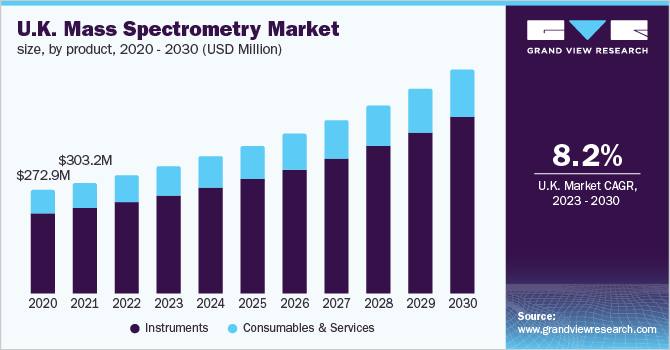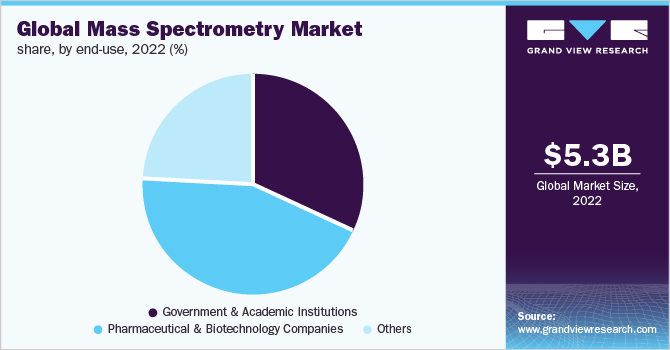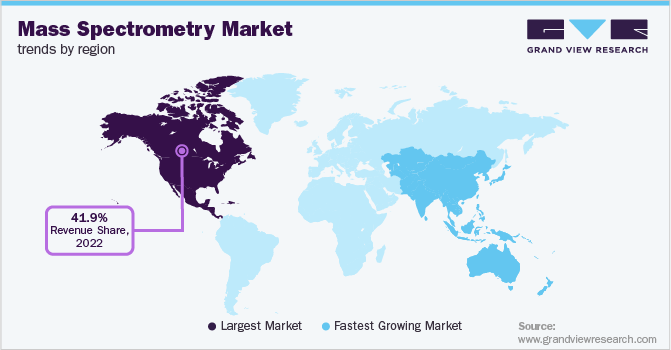- Home
- »
- Biotechnology
- »
-
Mass Spectrometry Market Size, Share, Growth Report, 2030GVR Report cover
![Mass Spectrometry Market Size, Share & Trends Report]()
Mass Spectrometry Market Size, Share & Trends Analysis Report By Product (Instruments, Consumables & Services), By Technology, By Application (Proteomics, Metabolomics), By End-use, By Region, And Segment Forecasts, 2023 - 2030
- Report ID: GVR-4-68039-998-3
- Number of Pages: 120
- Format: Electronic (PDF)
- Historical Range: 2018 - 2021
- Industry: Healthcare
Report Overview
The global mass spectrometry market size was valued at USD 5,262.5 million in 2022 and is expected to grow at a compound annual growth rate (CAGR) of 8.06% from 2023 to 2030. Mass spectrometry is used as an analytical method to characterize large biomolecules, such as DNA and proteins, and is widely used for omics-related studies. The primary application of mass spectrometry is in the field of drug discovery where it is used to identify structures of metabolites and drugs as well as for screening of metabolites in biological systems. Hence, with the increase in the prevalence of chronic diseases and rising R&D investments for the development of new diagnostic techniques, demand for mass spectrometry is expected to witness growth in the near future.

The COVID-19 pandemic has boosted the demand for vaccine development due to recent advancements in virology-based research. Here, mass spectrometry has applications for the study of viral structure for SARS-CoV-2. The technique can also be used to study complex protein structures and protein-protein interactions associated with the virus. Hence, various pharmaceutical and biotechnology companies involved in COVID-19 vaccine and drug development efforts are anticipated to increase the demand for mass spectrometry instruments and consumables.
Furthermore, the presence of established guidelines and recommendations by regulatory bodies and organizations for the use of mass spectrometry in the field of proteomics is another factor fueling market growth. For instance, in 2020, The Human Proteome Organization's Human Proteome Project (HPP) updated the guidelines on the data interpretation of mass spectrometry. The additional guidelines are for data-independent acquisition (DIA) workflows and the new Universal Spectrum Identifier system by the HUPO Proteomics Standards Initiative. These guidelines are set to ensure high accuracy and low false-positive protein identifications and are expected to enhance the efficiency of mass spectrometry workflows.
However, mass spectrometry systems are resource-centric and complex. These can incur high maintenance and operational costs or may require troubleshooting for maintaining optimal operating conditions. Moreover, the requirement of skilled labor for operating and maintaining such complex systems represents a key operational constraint faced by users. Such factors may limit the industry’s growth over the forecast period.
Product Insights
The instruments segment held the largest revenue share of 77.39% in 2022. Spectrometers offer a wide range of applications in the biotechnology sector and are witnessing rising awareness about the benefits of mass spectrometry workflows. These instruments can be used in clinical and preclinical testing for drug discovery as well as for biomedical research in the pharmaceutical industries.
For instance, high-resolution hybrid mass spectrometry can be used in the development of cell therapies for cancer treatment. Over the past few years, the technique has become important for proteomics-based research applications such as the determination of the molecular mass of peptides, and peptide sequences. Such advancements in mass spectrometry applications are anticipated to fuel the segment.
The consumables & services segment is projected to record a rapid CAGR of 8.93% over the forecast period due to the increasing demand for such products from various academic institutions and research centers. Such institutions offer researchers access to mass spectrometry systems in their labs at a nominal cost, and in turn, drive the demand for consumables. In addition, revenue from services such as maintenance and analytical testing is expected to grow with the increasing adoption of the technique for various academic and pharmaceutical research and development activities.
Technology Insights
Quadrupole liquid chromatography-mass spectrometry led with the largest share of 37.09% in 2022. Demand for this technology has grown significantly in the past few years due to the advantages offered by the technique. For instance, the triple quadrupole technology is one of the essential analytical techniques for clinical research analysis and can measure trace levels of biomarkers in complex matrices of biological fluids. Several key players have established offerings in this domain. For instance, Waters Corporation, a leading producer of this technology, offers mass spectrometry products used for the characterization of biomolecules for application in biotherapeutics, metabolomics, extracts, and leachable.
The Fourier transform-mass spectrometry (FT-MS) is the fastest-growing segment and is expected to grow at a CAGR of 8.78% over the forecast period. This can be attributed to the high resolving power, minimal error rate, high accuracy, and ease of operations offered by the technique. The technology also has applications in forensic laboratories for the identification of drugs and contraband substances such as cocaine. Such a broad range of applications can open new avenues for the growth of the segment in the coming years.
Application Insights
The proteomics segment held the largest revenue share of 46.69% in 2022. Mass spectrometry-based proteomics research is a comprehensive technique for quantitative profiling of proteins and studying protein-protein interactions. Advancements and the widespread availability of quantitative proteomics workflows have expanded the scope for studying protein function, structure, transformation, and overall protein dynamics.
In addition, developments in mass spectrometry technology are opening opportunities in single-cell analysis and clinical applications. The technology is anticipated to establish a strong position in various applications, including detecting novel biomarkers, mapping molecular tissue, and improving disease diagnosis. Such advancements are likely to fuel the growth prospects for the mass spectrometry market.
Metabolomics is projected to be the fastest-growing segment over the forecast period due to the wide range of applications of mass spectrometry in cancer screening and diagnosis. The technique can be used to study a vast number of compounds in a single sample which enables the analysis of multiple sample constituents in a single run. As metabolomics is gaining traction as an important omics technology for diagnostic and prognostic applications in several chronic and infectious diseases, the segment is expected to witness significant growth.
End-use Insights
The pharmaceutical and biotechnology companies segment dominated the market in 2022 with a share of 43.98% due to the extensive adoption of protein sequencing using mass spectrometry in the pharmaceutical industry for drug discovery and development processes. The growing demand for biomolecule analysis and drug component analysis is expected to further drive the segment growth for the market. With increasing investments in biopharmaceutical research and growth in research and development prospects in the proteomics domain, the segment is expected to witness lucrative growth in the coming years.

Government & academic institutions segment is expected to grow at a rapid CAGR of 8.02% over the forecast period due to the rise in healthcare expenditure, global increase in government funding for research activities, and increasing role of mass spectrometry techniques for disease surveillance and epidemiological research. Similarly, growth in COVID-19 testing activities and opportunities for the development of high throughput testing methods can considerably boost the market prospects.
Regional Insights
North America accounted for the largest market share of 41.94% in 2022 due to the high extent of research and development activities and the presence of an established research and healthcare infrastructure. Similarly, demand for mass spectrometry is also driven by increasing focus on disease prevention measures in the region. Furthermore, government funding in the region is considerably strong and is likely to fuel market growth. For instance, UniProt, a free-of-cost portal for obtaining protein sequencing and functional information is supported by various government institutions, including the National Eye Institute, National Heart, Lung, and National Human Genome Research Institute.

The Asia Pacific region is expected to grow at the fastest CAGR of 8.97% over the forecast period due to the availability of a large population and rising focus on healthcare systems. Similarly, the rising attention drawn by proteomics and genomics research, as well as the increase in initiatives undertaken by academic institutions for the development of protein-based therapeutics have presented significant growth opportunities for the market in the Asia Pacific region.
Key Companies & Market Share Insights
The market is highly competitive due to several strategic initiatives such as new product launches, mergers and acquisitions, and regional expansion, undertaken by key market players to increase their global footprints. For instance, in November 2021, Thermo Fisher Scientific, Inc. launched new additions to its portfolio of mass spectrometry and chromatography offerings at the American Society for Mass Spectrometry Conference in Pennsylvania, U.S. Key participants in the global mass spectrometry market include:
-
Thermo Fisher Scientific, Inc.
-
Agilent Technologies, Inc.
-
Danaher Corporation
-
Waters Corporation
-
BrU.K.er Corporation
-
Shimadzu Corporation
-
PerkinElmer, Inc.
-
Rigaku Corporation
-
LECO Corporation
-
JEOL Ltd.
Recent Developments
-
In June 2023, Thermo Fisher Scientific, Inc. introduced the Thermo ScientificTM OrbitrapTM AstralTM mass spectrometer. The Astral analyzer enables researchers to effectively identify proteins, leading to ground-breaking discoveries for clinical biomarkers, diseases, and therapies.
-
In June 2023, Agilent Technologies, Inc. introduced the Inspirational LC/TQ and LC/Q-TOF Mass Spectrometry Solutions. The Agilent 6495 Triple Quadrupole LC/MS is an ideal choice for targeted analysis, offering high sensitivity, and the Agilent Revident Quadrupole Time-of-Flight LC/MS (LC/QTOF) System is an intelligent instrument architecture for efficient operation and productivity.
-
In June 2023, Bruker introduced the timsTOF Ultra Mass Spectrometer with Transformative Sensitivity, 300 Hz PASEF MS/MS, and VistaScanTM for Enhanced Dia-PASEF® 4D-ProteomicsTM. This system uses a CSI Ultra ion source, a 4th-generation TIMS XR cell, and a 14-bit digitizer for peptide identification, ensuring sensitivity and quantitation in ultra-low sample amounts.
-
In June 2023, Bruker introduced the Novel EVOQTM DART-TQ+ for Chromatography-Free Mass Spectrometry. This system delivers ultimate sensitivity for comprehension screening and quantitation tasks.
-
In June 2022, Thermo Fisher Scientific, Inc. collaborated with TransMIT GmbH. This collaboration intended to create a High-Performance Orbitrap Mass Spectrometry imaging platform for integrated mass spectrometry imaging systems. This system provides a label-free method for mapping the distribution of a diverse set of biological tissue.
-
In June 2022, Agilent Technologies, Inc. introduced Revolutionary Quadrupole mass spectrometers. The New LC/TQ and GC/TQ simplify new lab operations and utilize HydroInert sources for enhanced performance.
Mass Spectrometry Market Report Scope
Report Attribute
Details
Market size value in 2023
USD 5,637.2 million
Revenue forecast in 2030
USD 9,697.0 million
Growth rate
CAGR of 8.06% from 2023 to 2030
The base year for estimation
2022
Historical data
2018 - 2021
Forecast period
2023 - 2030
Quantitative units
Revenue in USD million and CAGR from 2023 to 2030
Report coverage
Revenue forecast, company ranking, competitive landscape, growth factors, and trends
Segments covered
Product, technology, application, end-use, region
Regional scope
North America; Europe; Asia Pacific; Latin America; MEA
Country scope
U.S.; Canada; Germany; France; U.K.; Italy; Spain; Japan; China; India; Australia; South Korea; Brazil; Mexico; Argentina; South Africa; Saudi Arabia; UAE
Key companies profiled
Thermo Fisher Scientific, Inc.; Agilent Technologies, Inc; Danaher Corporation; Waters Corporation; BrU.K.er Corporation; Shimadzu Corporation; PerkinElmer, Inc.; Rigaku Corporation; LECO Corporation; JEOL Ltd.
Customization scope
Free report customization (equivalent up to 8 analyst’s working days) with purchase. Addition or alteration to country, regional & segment scope.
Pricing and purchase options
Avail customized purchase options to meet your exact research needs. Explore purchase options
Global Mass Spectrometry Market Segmentation
This report forecasts revenue growth at the global, regional, and country levels and provides an analysis of the latest industry trends in each of the sub-segments from 2018 to 2030. For this report, Grand View Research has segmented the global mass spectrometry market report based on product, technology, application, end-use, and region:
-
Product Outlook (Revenue, USD Million, 2018 - 2030)
-
Instruments
-
Consumables & Services
-
-
Technology Outlook (Revenue, USD Million, 2018 - 2030)
-
Quadrupole Liquid Chromatography-Mass Spectrometry
-
Gas Chromatography-Mass Spectrometry (GC-MS)
-
Fourier Transform-Mass Spectrometry (FT-MS)
-
Time-of-Flight Mass Spectrometry (TOFMS)
-
Matrix-Assisted Laser Desorption/Ionization-Time-of-Flight Mass Spectrometry (MALDI-TOF)
-
Magnetic Sector Mass Spectrometry
-
Others
-
-
Application Outlook (Revenue, USD Million, 2018 - 2030)
-
Proteomics
-
Metabolomics
-
Glycomics
-
Others
-
-
End-use Outlook (Revenue, USD Million, 2018 - 2030)
-
Government & Academic Institutions
-
Pharmaceutical & Biotechnology Companies
-
Others
-
-
Regional Outlook (Revenue, USD Million, 2018 - 2030)
-
North America
-
U.S.
-
Canada
-
-
Europe
-
U.K.
-
Germany
-
France
-
Italy
-
Spain
-
-
Asia Pacific
-
Japan
-
China
-
India
-
Australia
-
South Korea
-
-
Latin America
-
Brazil
-
Mexico
-
Argentina
-
-
Middle East and Africa (MEA)
-
South Africa
-
Saudi Arabia
-
UAE
-
-
Frequently Asked Questions About This Report
b. The global mass spectrometry market size was estimated at USD 5.83 billion in 2021 and is expected to reach USD 6.23 billion in 2022.
b. The global mass spectrometry market is expected to grow at a compound annual growth rate of 7.87% from 2022 to 2030 to reach USD 11.43 billion by 2030.
b. North America dominated the mass spectrometry market with a share of 41.66% in 2021. This is attributable to the presence of well-established research institutes and R&D plants of various pharmaceutical companies
b. Some key players operating in the mass spectrometry market include Thermo Fisher Scientific, Inc.; Agilent Technologies, Inc.; Danaher Corporation; Waters Corporation; Bruker Corporation; Shimadzu Corporation; PerkinElmer, Inc.; Rigaku Corporation; LECO Corporation; JEOL Ltd.
b. Key factors that are driving the mass spectrometry market growth include increasing spending on drug discovery and development, along with the increase in the prevalence of chronic diseases and the need for the development of new diagnostic techniques
Share this report with your colleague or friend.
![gvr icn]()
NEED A CUSTOM REPORT?
We can customize every report - free of charge - including purchasing stand-alone sections or country-level reports, as well as offer affordable discounts for start-ups & universities. Contact us now
![Certified Icon]()
We are GDPR and CCPA compliant! Your transaction & personal information is safe and secure. For more details, please read our privacy policy.
We are committed towards customer satisfaction, and quality service.
"The quality of research they have done for us has been excellent."





